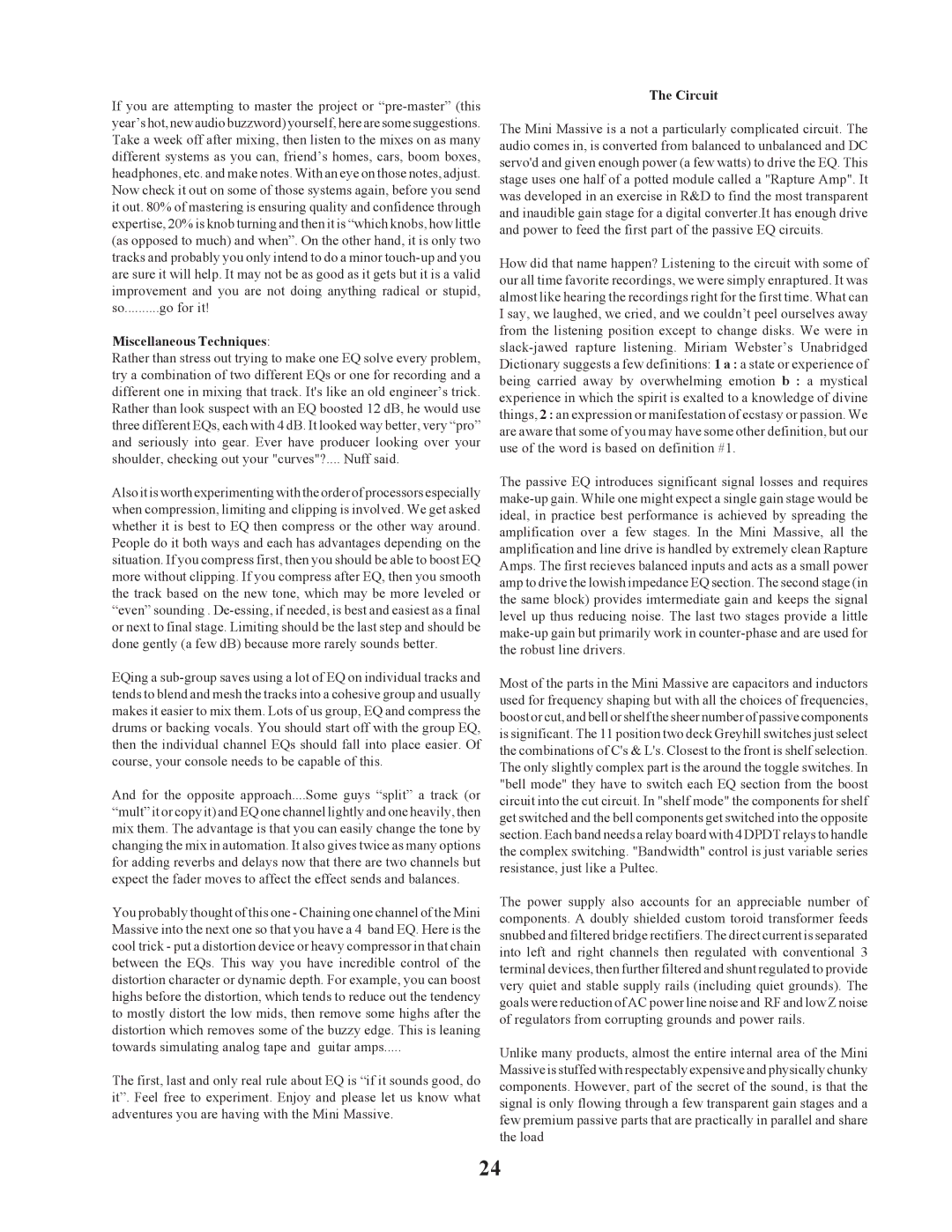If you are attempting to master the project or
Miscellaneous Techniques:
Rather than stress out trying to make one EQ solve every problem, try a combination of two different EQs or one for recording and a different one in mixing that track. It's like an old engineer’s trick. Rather than look suspect with an EQ boosted 12 dB, he would use three different EQs, each with 4 dB. It looked way better, very “pro” and seriously into gear. Ever have producer looking over your shoulder, checking out your "curves"?.... Nuff said.
Also it is worth experimenting with the order of processors especially when compression, limiting and clipping is involved. We get asked whether it is best to EQ then compress or the other way around. People do it both ways and each has advantages depending on the situation. If you compress first, then you should be able to boost EQ more without clipping. If you compress after EQ, then you smooth the track based on the new tone, which may be more leveled or “even” sounding .
EQing a
And for the opposite approach....Some guys “split” a track (or
“mult” it or copy it) and EQ one channel lightly and one heavily, then mix them. The advantage is that you can easily change the tone by changing the mix in automation. It also gives twice as many options for adding reverbs and delays now that there are two channels but expect the fader moves to affect the effect sends and balances.
You probably thought of this one - Chaining one channel of the Mini Massive into the next one so that you have a 4 band EQ. Here is the cool trick - put a distortion device or heavy compressor in that chain between the EQs. This way you have incredible control of the distortion character or dynamic depth. For example, you can boost highs before the distortion, which tends to reduce out the tendency to mostly distort the low mids, then remove some highs after the distortion which removes some of the buzzy edge. This is leaning towards simulating analog tape and guitar amps.....
The first, last and only real rule about EQ is “if it sounds good, do it”. Feel free to experiment. Enjoy and please let us know what adventures you are having with the Mini Massive.
The Circuit
The Mini Massive is a not a particularly complicated circuit. The audio comes in, is converted from balanced to unbalanced and DC servo'd and given enough power (a few watts) to drive the EQ. This stage uses one half of a potted module called a "Rapture Amp". It was developed in an exercise in R&D to find the most transparent and inaudible gain stage for a digital converter.It has enough drive and power to feed the first part of the passive EQ circuits.
How did that name happen? Listening to the circuit with some of our all time favorite recordings, we were simply enraptured. It was almost like hearing the recordings right for the first time. What can I say, we laughed, we cried, and we couldn’t peel ourselves away from the listening position except to change disks. We were in
The passive EQ introduces significant signal losses and requires
Most of the parts in the Mini Massive are capacitors and inductors used for frequency shaping but with all the choices of frequencies, boost or cut, and bell or shelf the sheer number of passive components is significant. The 11 position two deck Greyhill switches just select the combinations of C's & L's. Closest to the front is shelf selection. The only slightly complex part is the around the toggle switches. In "bell mode" they have to switch each EQ section from the boost circuit into the cut circuit. In "shelf mode" the components for shelf get switched and the bell components get switched into the opposite section. Each band needs a relay board with 4 DPDT relays to handle the complex switching. "Bandwidth" control is just variable series resistance, just like a Pultec.
The power supply also accounts for an appreciable number of components. A doubly shielded custom toroid transformer feeds snubbed and filtered bridge rectifiers. The direct current is separated into left and right channels then regulated with conventional 3 terminal devices, then further filtered and shunt regulated to provide very quiet and stable supply rails (including quiet grounds). The goals were reduction of AC power line noise and RF and low Z noise of regulators from corrupting grounds and power rails.
Unlike many products, almost the entire internal area of the Mini Massive is stuffed with respectably expensive and physically chunky components. However, part of the secret of the sound, is that the signal is only flowing through a few transparent gain stages and a few premium passive parts that are practically in parallel and share the load
24
